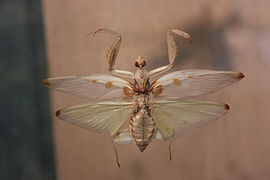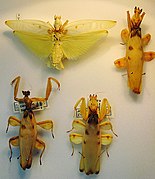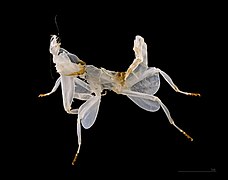ഓർക്കിഡ് മാന്റിസ്
| ഓർക്കിഡ് മാന്റിസ് | |
|---|---|
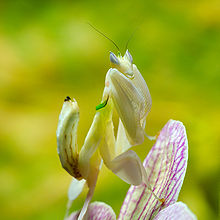
| |
| Sub-adult female | |
| Scientific classification | |
| കിങ്ഡം: | |
| Phylum: | |
| Class: | |
| Order: | |
| Family: | |
| Genus: | |
| Species: | H. coronatus
|
| Binomial name | |
| Hymenopus coronatus Olivier, 1792
| |
| Synonyms | |
|
H. bicornis (Stoll) | |
തെക്കുകിഴക്കേ ഏഷ്യയിലെ മഴക്കാടുകളിൽ കാണുന്ന ഒരു തൊഴുകയ്യൻ പ്രാണിയാണ് ഓർക്കിഡ് മാന്റിസ് (Hymenopus coronatus). ഇത് H. bicornis, എന്നും അറിയപ്പെടുന്നു. walking flower mantis, (pink) orchid mantis എന്നെല്ലാം ഇതിനു പേരുകൾ ഉണ്ട്. സ്വഭാവവും കാഴ്ചയിലെ രീതിയും അനുസരിച്ച് പലതരത്തിലുള്ള ഫ്ലവർ മാന്റിസുകളിൽ ഒന്നാണിത്. കാട്ടിൽ H. coronatus -നെ മലേഷ്യയിൽ കാണാറുണ്ട്.[1]
വിവരണം
[തിരുത്തുക]ഓർക്കിഡ് പൂവിന്റെ ഭാഗമെന്നരീതിയിലുള്ള മിമിക്രിക്കും പ്രച്ഛന്നവേഷത്തിനും യോജിച്ചരീതിയിൽ ആണ് ഇതിന്റെ അതീവഭംഗിയാർന്ന നിറഭേദങ്ങൾ. നടക്കാനുതകുന്ന നാലുകാലുകളാവട്ടെ പൂവിന്റെ ഇതളുകൾ പോലെതോന്നും. [2] പല്ലുകളുള്ള മുന്നിലെ കാലുകളുടെ ജോഡി ഇരയെ പിടിക്കാനും ഉപയോഗിക്കുന്നു.
ഏതൊരു തൊഴുകയ്യൻ പ്രാണി ഇനങ്ങളിലും ഇത്രയ്ക്കും ആൺപെൺ വ്യതിയാനമുള്ള വേറെ സ്പീഷിസ് ഇല്ലെന്നുതന്നെ പറയാം: ആണുങ്ങൾ പെണ്ണുങ്ങളുടെ പകുതിമാത്രം വലിപ്പമുള്ളവരാണ്.[3]
ഉണ്ടായി വരുന്ന നിംഫുകളുടെ ആദ്യകാലരൂപം റെഡുവിഡേ കുടുംബത്തിലെ പ്രാണികളെ അനുസ്മരിപ്പിക്കുന്നതാണ്. ഇവയുടെ കടി ശക്തിയേറിയതും ഇവയ്ക്ക് മോശം രുചിയുള്ളതുമാണ്.[4]
പിന്നാമ്പുറത്തിന്റെ നിറമനുസരിച്ച് ഇവയ്ക്ക് പിങ്കിനും ബ്രൗണിനും ഇടയിൽ നിറം മാറാൻ കഴിവുള്ളവയാണ്.[5]
കാണുന്ന ഇടങ്ങൾ
[തിരുത്തുക]Hymenopus coronatus നെ തെക്കുകിഴക്കേ ഏഷ്യയിലെ മഴക്കാടുകളിലാണ് കാണുന്നത്.[6] മലേഷ്യയിലും, മ്യാന്മറിലും, തായ്ലാന്റിലും ഇന്തോനേഷയിലും ഇവയെ കണ്ടുവരുന്നു.
സ്വഭാവം
[തിരുത്തുക]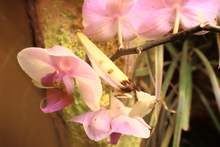
ഭക്ഷണരീതി
[തിരുത്തുക]മാംസഭോജികളായ ഇവ, വളർത്തുന്ന അവസരങ്ങളിൽ ശലഭങ്ങളെ ഭക്ഷിക്കാൻ ഇഷ്ടപ്പെടുന്നവയാണ്.[7] ചെറുപ്രാണികളും തുള്ളന്മാരും, ഈച്ചകളും, വണ്ടുകളും, തേനീച്ചപോലെയുള്ള കുത്തുന്ന പ്രാണികളെയും ഇവ തിന്നാറുണ്ട്. അധികം അടുത്തുവന്നാൽ സ്വന്തം സ്പീഷിസിനെയും ഇവ പിടിച്ചുതിന്നാറുണ്ട്. തന്നെക്കാളും വലിപ്പമുള്ള നട്ടെല്ലുള്ള ജീവികളായ പല്ലികളെയും, പക്ഷികളെയും, തവളകളെയും ആമകളെയും എലികളെയും തിന്നാൻ സമർത്ഥരാണ് തൊഴുകയ്യൻ പ്രാണികൾ.[8]
മനുഷ്യസംസ്കാരത്തിൽ
[തിരുത്തുക]ചരിത്രം
[തിരുത്തുക]
1889-ലെ "ഡാർവിനിസം" എന്ന പുസ്തകത്തിൽ, ആൽഫ്രഡ് റസ്സൽ വാലസ് തൊഴുകൈയ്യൻ പ്രാണി അപൂർവ്വം ആണെന്നറിയപ്പെടുന്നു.
A beautiful drawing of this rare insect, Hymenopus bicornis (in the nymph or active pupa state), was kindly sent me by Mr. Wood-Mason, Curator of the Indian Museum at Calcutta. A species, very similar to it, inhabits Java, where it is said to resemble a pink orchid. Other Mantidae, of the genus Gongylus, have the anterior part of the thorax dilated and coloured either white, pink, or purple; and they so closely resemble flowers that, according to Mr. Wood-Mason, one of them, having a bright violet-blue prothoracic shield, was found in Pegu by a botanist, and was for a moment mistaken by him for a flower. See Proc. Ent. Soc. Lond., 1878, p. liii.
— Alfred Russel Wallace[9]
The drawing was published in Edward Bagnall Poulton's book The Colours of Animals. Poulton calls it an "Indian Mantis" which "feeds upon other insects which it attracts by its flower-like shape and pink colour. The apparent petals are the flattened legs of the insect."[10]
വളർത്തൽ
[തിരുത്തുക]പ്രാണികളെ വളർത്തുന്നവർക്ക് ഏറെ പ്രിയപ്പെട്ടതാണ് ഓർക്കിഡ് മാന്റിസ്. വളരെ അപൂർവ്വമായതിനാൽ വലിയ വിലയേറിയതാണ് ഇവ.
ചിത്രശാല
[തിരുത്തുക]-
Mounted adult male
-
Mounted female
-
Display of adult females
-
Last instar exuviae
-
Late instar female
-
Late instar female on flowers from Chiang Mai Province, Thailand
-
Adult male
ഇവയും കാണുക
[തിരുത്തുക]- List of mantis genera and species
- Flower mantis
അവലംബം
[തിരുത്തുക]- ↑ https://www.keepinginsects.com/praying-mantis/species/orchid-mantis/
- ↑ Gullan, PJ; Cranston, PS (2010). The Insects: An Outline of Entomology. Wiley (4th edition). Page 370.
- ↑ Prete, 1999. p.107.
- ↑ Gurney (1951). "Praying Mantids". Annual Report of the Board of Regents of the Smithsonian Institution. 105. The Smithsonian Institution: 344–345.
- ↑ Prete, 1999. pp. 283–184.
- ↑ DK Pocket Eyewitness Insects. Dorling Kindersley. 2012. p. 38.
- ↑ Prete, 1999. p.313.
- ↑ "Hymenopus Coronatus (Orchid mantis) Caresheet". InsectStore. 25 January 2006. Retrieved 5 January 2013.
- ↑ Wallace, 1889. Note 80.
- ↑ Poulton, 1890. pp 74–75.
സഹായക ഗ്രന്ഥങ്ങൾ
[തിരുത്തുക]- Cott, Hugh Bamford (1940). Adaptive Coloration in Animals. London: Methuen.
- Poulton, Edward Bagnall (1890). The Colours of Animals: Their Meaning and Use, Especially Considered in the Case of Insects. Kegan Paul, Trench, Trübner. pp. 74–75.
- Prete, Frederick R (1999). The Praying Mantids. JHU Press. p. 313.
- Wallace, Alfred Russel (1889). . Macmillan.
{{cite book}}:|format=requires|url=(help)


